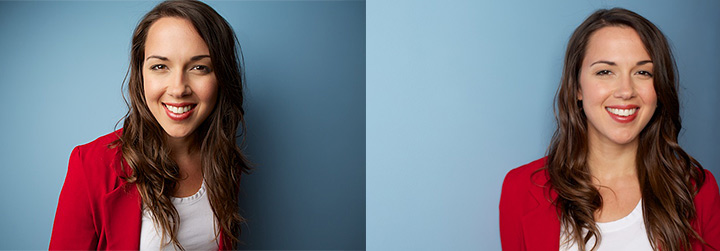
“I had recently taken some headshots for a friend of a friend, and had begun experimenting with focal lengths. Previously, the widest I would go was 50mm, but with the picture below I tried my seldom-used 24mm on for size. Attached to this email is my favourite pic from the shoot at 24, followed by a pic I took immediately afterwards at 50mm, which seems so dull and flat to me by comparison. I don’t know if the 50 is to blame, or I just never would have picked that shot, but the 24mm shot has so much more life and depth to me that I felt I had really hit upon something. Even the lighting has more texture and natural vignetting, which I did not think would be affected. All said, subsequent shoots have not really supported what I thought would be a revolution in my picture-taking. Other photographic subjects don’t seem to have held up as well. Also, I haven’t heard back from my subject as to which images she prefers so I’m worried that in her eyes that my wider pictures have in fact distorted features that she’s sensitive about.”
Right off, your subject has absolutely nothing to be sensative about. That’s a beautiful woman. Nice choice of background color to contrast the red jacket.
Now as for the focal length question, as many of my readers know, I’m a bigger fan of using wider-angle lenses for portraits than conventional wisdom dictates. For me it’s less about getting closer to the subject and more about including more of their environment in the shot, which I think gives context to the portrait and often ‘room to breathe’ visually. That said, a little distortion can also be a good thing. As an example I was looking at this picture of my friend Abby the other day with satisfaction. I think that was taken with a 35mm lens.
I agree that your 24mm image on the left is the better shot of the two by far. However there is a lot more at play than focal length. The light is off to the side giving her features more dimensionality and the fact that her body is turned into the camera helps that as well. It also feels like a more real smile to me, and authenticity is huge. I also agree that the vignetting helps pull your eyes to her face. The shot on the right feels flat in comparison.
So the wide totally works in this instance, but it won’t always. Depends on the subject and the situation. Also 50mm is a classic focal-length but it’s also pretty boring. Don’t get me wrong, I shoot 50 all the time, but it’s basically what you see with your own eyes and without the camera. It’s what people’s minds expect. Many portrait photographers go the other way and shoot 85mm, 135mm, even 200mm, in an attempt to distort in the other direction by flattening features as much as possible. This may sometimes give you more flattering results, but I tend to think they’re also usually boring.
Good on you to try something new. I think it’s successful. OK, part two:
Unfortunately it doesn’t quite work that way. Focal lengths are really only important in that they define your field of view. If you had the same 24mm on a Rebel it would be the equivalent of a 38mm lens (24mmx1.6 crop factor) on a full frame body. Acting closer to 50mm than 24mm. So basically you’d end up with something closer to the shot on the right than the one on the left. Cropped sensors are less expensive and give you an advantage in increased depth-of-field because you’d be further from the subject to take the same shot vs a full frame camera, but they don’t really effect the wide-angle equation in the way you ask. Plus because cropped sensors throw away the edges of the image coming through the lens so you’d also lose all that nice vignetting you’ve fallen in love with.
Thanks to John for the great question and example images.
